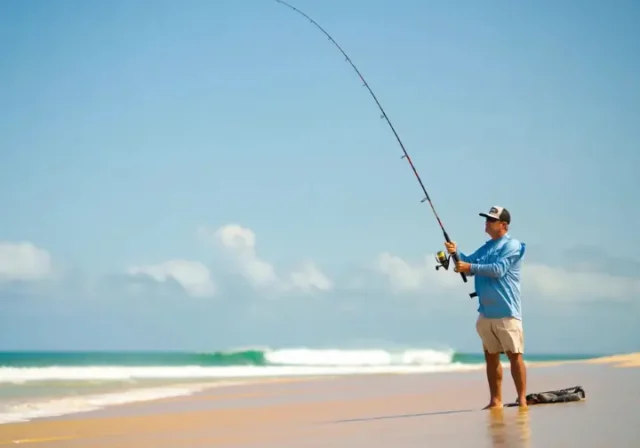In this article
Choosing the right surf fishing rod can feel like navigating tricky currents. Get it right, and you’re casting like a pro; get it wrong, and you’re fighting your gear instead of the fish. This guide will serve as your map for surf-fishing, breaking down the essentials like rod length, power, and action, and highlighting top picks for 2025. We’ll cover matching your fishing rod or fishing pole to your target species and fishing style, whether you prefer lure fishing or soaking fishing bait.
We’ll explore options across different budgets, including reliable workhorses and premium performers, even touching on travel-friendly choices among fishing rods. By the end, you’ll understand how to select the ideal surf rod, pair it with the right fishing reels and fishing line, and care for your gear to ensure many successful seasons battling the surf. Ready to cast off? Let’s find the best fishing rod for surf fishing that makes you the boss of the beach.
Understanding Surf Rod Essentials
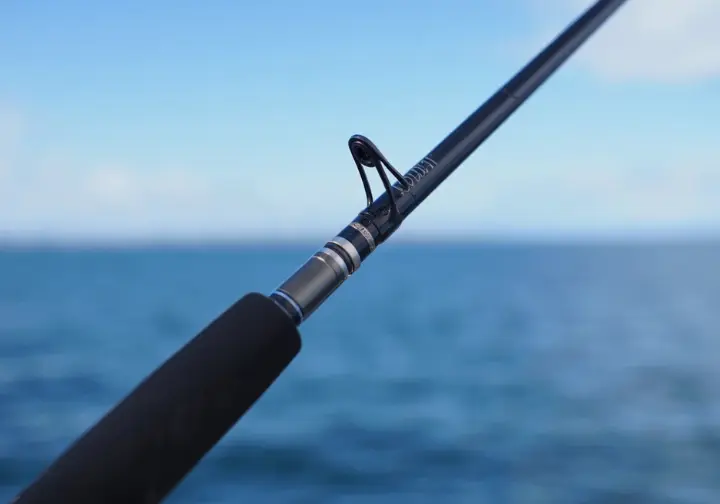
Getting to grips with the core features of a surf rod is the first cast towards making a great choice. We’ll look at the key technical aspects – length, power, action, and materials – that define how a rod performs when facing the waves and the fishes hiding within them. Understanding these is key before making a rod buy.
Decoding Rod Length Nuances
Surf rod length, often between 9 and 12 feet, plays a big part in casting distance and keeping your line clear of the breaking waves. A long fishing rod, typically 11 feet or more, helps launch rigs further and manage line effectively in the surf, though they can feel unwieldy. Shorter rod options, around 9 to 10 feet (like many nine-foot surf rods), offer improved control, particularly useful when fishing from jetties or casting lighter applications. A 10-foot rod is often a versatile starting point.
The sweet spot often balances casting requirements with angler comfort and the fishing location; a 9-to-12-foot surf fishing rod provides good versatility. For very light work or calmer back bay areas, a 7-foot rod or 8-foot rod might suffice. Conversely, rods stretching 11 to 14 feet or longer (like a 13-foot-long surf rod) are usually reserved for maximum distance casting with heavy baits, aiming for powerful species like sharks or large drum. A 12-foot rod offers significant reach.
On open beaches facing moderate to heavy surf, those longer surf rods truly shine. They keep the line high, minimizing wave interference and helping you stay connected to your rig to detect bites. Think of it like keeping your antenna clear for the best signal when fish biting. Shorter rods, however, provide better maneuverability in tight spots like jetties or piers – a common jetty fishing scenario. They’re also generally lighter, reducing fatigue during long casting sessions. A lightweight jetty rod can make jetty fishing trips much more enjoyable.
Choosing involves thinking about where you fish most often, the size of fish you expect, and typical wave conditions. A rod you handle well is often more effective than simply the longest one available. Practicalities like transport matter too; most surf fishing rods come in two pieces, but even then, longer rods need space. Consider how easily you can carry and store your chosen rod length. A nine-foot rod is much easier to transport than a 13-foot-long rod.
Lastly, rod length affects leverage during the fight. While longer rods help clear the line, they can sometimes give big fish an advantage, demanding good technique from the fisherman to manage the battle effectively. The extra rod length requires careful handling.
Understanding Rod Power Ratings
Rod power indicates the blank’s lifting strength – how much it resists bending. For surf fishing, this is key for casting the right weight and battling fish effectively. Surf rods commonly range from Medium (M) to Heavy (H), with Medium-Heavy (MH) being a popular all-around choice. This power rating typically handles common sinker and bait weights (2-6 oz) and popular species like striped bass well, making it a solid striped bass rod.
Matching the rod’s power to your lure or sinker weight is fundamental. Using weights outside the recommended range compromises casting and can even damage the fishing rod. A Medium-Heavy rod often covers that versatile 2-6 oz sweet spot, suitable for many bait and tackle scenarios. A heavy-action fishing rod or heavier power rods become necessary when chasing very large fish or using hefty sinkers (8oz+) to hold bottom in strong currents.
Lighter Medium power rod options suit smaller species like pompano or surf perch, or when using lures under 3oz. They offer better sensitivity for detecting subtle bites but might lack the muscle for bigger fish or rougher conditions. Think about the fighting style of your target fish too. A powerful rod is needed for swimmers demanding rods with enough backbone to control them in the surf wash.
Keep in mind that power ratings can differ slightly between manufacturers. Always check the specific lure and fishing line weight ratings printed on the rod blank itself. This power rating also influences how well you can set the hook, especially at a distance. Heavier power rods generally drive hooks home more effectively, important for fish with tough mouths.
Choosing Appropriate Rod Action
Rod action tells you where the rod bends when pressure is applied. This affects casting, sensitivity, and hook setting. Common actions for surf rods are Moderate, Moderate-Fast, and Fast. Each offers distinct benefits depending on your preferred fishing technique. A faster rod will feel different from a slower-loading rod.
Moderate action rods bend deeper, more towards the middle of the blank. This provides a smoother, lobbing cast ideal for heavy bait rigs (like chunk baits or small chunk baits), helping keep bait intact during the cast. This deeper flex also acts like a shock absorber during fights, reducing the chance of pulled hooks, especially with treble hooks found on many lures. A moderate-action rod is often preferred by bait fishermen.
Fast action rods bend mainly near the rod tip. This translates to high sensitivity for feeling subtle bites and quick, powerful hooksets. Anglers who primarily fish artificial lures (“plugging”) often favor fast-action rods or fast rods for better lure manipulation and immediate strike response. What signals do you look for when detecting a bite?
Moderate-Fast action rods strike a balance, bending slightly deeper than fast actions but still offering good sensitivity and hook-setting capability. They represent a versatile compromise, suitable for anglers who switch between bait fishing and casting lures frequently. Slow action rods, bending deep into the butt, maximize casting distance with very heavy weights but are less common due to reduced sensitivity.
Your primary fishing style should guide your action choice: Fast for lures and feeling bites, Moderate for heavy bait and shock absorption, and Moderate-Fast for all-around use. The action works in concert with the hook type; moderate actions cushion treble hooks, while fast actions excel with single bait hooks.
Material Matters: Blank Construction
The heart of the fishing rod, the blank, is typically made from Fiberglass, Graphite (also called Carbon Fiber), or a Composite blend of the two. Each material brings different qualities regarding weight, sensitivity, durability, and cost. Graphite has become the go-to for performance-oriented rods due to its lightness and ability to transmit vibrations. Understanding rod technology helps in appreciating these differences.
Graphite blanks are noticeably lighter and stiffer than fiberglass. This results in better bite detection and faster recovery during casting, leading to increased distance and accuracy. Higher grades of graphite (often denoted by terms like ‘modulus’ or ‘tonnage’, seen in super-high-modulus surf rods) are even lighter and more sensitive but can be more brittle and susceptible to impact damage. The rod feel is significantly different.
Fiberglass, on the other hand, is renowned for its exceptional durability and flexibility. It’s very forgiving and stands up well to the rough handling sometimes unavoidable in the surf. The trade-off is increased weight and reduced sensitivity compared to graphite, which can lead to fatigue and missed bites. Have you ever experienced rod breaks in the surf?
Composite blanks aim for the best of both worlds, blending graphite for sensitivity and lightness with fiberglass for toughness. This construction is common in many mid-range surf rods, offering solid all-around performance and resilience. Manufacturers also employ proprietary technologies, like specific graphite types or wrapping techniques (e.g., Shimano’s Spiral X, Daiwa’s X45), to boost strength, cut weight, and prevent twisting for better casting. There are many good fishing rods using these blends.
Beyond the blank, high-quality fishing rods depend on quality components. Look for corrosion-resistant guides (like Fuji K-series or SeaGuide) with durable ring materials (Alconite, SiC) and sturdy reel seats. Stainless steel or titanium guide frames offer the best protection against saltwater. Handle materials like cork, EVA foam, or rubber shrink tube influence grip and longevity; rubber shrink tube is particularly favored for its excellent wet grip and durability. Some custom rod builders offer unique handle configurations. Even inshore rods and kayak rods benefit from these quality materials.
Selecting Your Ideal Rod

Moving beyond the technical specifications, choosing the best surf fishing rod involves aligning the gear with your personal fishing reality. Consider your typical target species, preferred methods (lures or bait), common fishing spots, budget constraints, and how easily you need to transport the rod. It’s about finding the right tool for your specific fishing scenarios.
Matching Rod to Target Species
The size and fighting style of the fish you chase heavily influence your choice of rod power. For smaller quarry like surf perch or pompano, lighter rods (Medium or lighter) provide the necessary sensitivity to detect their often subtle bites. You wouldn’t use a sledgehammer to tap in a finishing nail, right? Targeting perch requires a different approach than targeting sharks.
Conversely, battling powerful fish such as striped bass (stripers), redfish, or bluefish requires a Medium-Heavy or Heavy power rod. These fishing rods possess the backbone needed to manage strong runs, turn the fish’s head, and pull them through the surf zone without being overwhelmed. Using an underpowered rod can lead to frustratingly long fights and lost fish right at the shoreline. You might even encounter kingfish, needlefish, or the occasional blowfish or dogfish.
For the giants of the surf, like sharks or massive drum, specialized heavy-duty surf rods (Heavy or Extra-Heavy power) are essential. These are built for maximum lifting power and casting extremely heavy baits and sinkers needed to reach and hold in their feeding zones. Always consider the potential maximum size fish you might hook in your area – you want to be prepared for that big fish or heavy fish. Even largemouth bass fishermen venturing into the salt need to adjust their gear.
Rod action also contributes. A moderate action can help absorb the sudden head shakes of powerful fish, reducing the risk of the hook pulling free. A fast action delivers the speed needed for quick hooksets on fish with tougher mouths, like speckled trout. Researching common catches and local regulations through bait and tackle shops or state agency websites provides valuable guidance for fishermen. A versatile 10-11ft Medium-Heavy, Moderate-Fast rod often serves as a great starting point for handling a variety of common surf species, making it a good all-around surf rod. Some fishermen target trout in specific brackish areas accessible from the surf.
Lure vs. Bait Fishing Needs
Do you prefer actively casting and retrieving lures, or patiently soaking bait? Your answer steers your rod choice. Anglers focused on “plugging” (lure fishing) typically benefit from Fast or Moderate-Fast action rods. These provide the sensitivity to feel the lure’s action and detect strikes, plus the quick response needed for hooksets. Lighter graphite blanks also reduce fatigue during constant casting. These are often called lure rods.
Bait fishing often involves launching heavy rigs considerable distances and letting them sit. Here, casting power and rod strength take precedence over pinpoint sensitivity. Moderate or Moderate-Fast action rods load well under heavy payloads (sinker + bait) and offer the backbone required to pull fish through the surf wash. Ensure the rod’s lure rating matches the weight range you typically cast – whether it’s live bait, cut bait, or chunk baits. These are your classic bait rods.
For lure fishing, a rod length between 9 and 11 feet usually strikes a good balance between casting distance and the maneuverability needed to work plugs or jigs effectively. Feeling subtle changes in lure movement or tentative bites is key. Bait anglers, including chunk bait fishermen, often lean towards longer rods (10-12+ feet) to maximize casting distance with heavy rigs and keep the line higher over breaking waves, paired with a strong MH or H power backbone. A dedicated heavy bait rod or heavy-action bait rod excels here.
If you enjoy both techniques, a versatile Moderate-Fast action rod, perhaps 10-11 feet long with Medium-Heavy power, offers a solid compromise. Some rods are specifically designed for plugging, featuring premium lightweight blanks and sensitive tips, often at a higher price point, but delivering top performance for lure enthusiasts. Others are considered great bait sticks. Consider the typical light bait versus heavier options like live baits when selecting your medium-weight bait rod. Even techniques like shore fluke fishing have specific bait rod preferences.
Budget & Portability Factors
Surf rods span a wide price spectrum, from under $100 for basic models to well over $500 for high-end or custom builds, including potentially expensive fishing rods. Setting a realistic budget early helps narrow the field. Many anglers find the best value in the mid-range ($100-$250), where brands like Penn, Okuma, Tsunami, and Daiwa offer significant performance gains over entry-level options without the premium price tag. A solid mid-range rod is often a great investment.
While budget rods are functional, investing more typically brings improvements in weight reduction, sensitivity, casting efficiency, component quality (guides, reel seat), and overall durability. A higher-quality fishing rod can genuinely enhance the fishing experience and often lasts longer if cared for properly. What’s the most you’ve spent on a fishing rod? Are you looking for a new rod or upgrading an old stick rod?
Portability is another practical consideration. Most surf rods break down into two pieces, commonly splitting either 50/50 or using a 70/30 butt-joint design aimed at mimicking a one-piece feel. For maximum portability, especially for air travel or hiking, dedicated travel surf rods break down into 3, 4, or even 5 pieces, fitting easily into luggage.
While modern multi-piece rods perform admirably, the extra joints (ferrules) can introduce slight compromises in action or strength compared to one or two-piece models. However, the convenience they offer for traveling anglers is undeniable. Weigh the trade-offs: peak performance from a two-piece versus the go-anywhere convenience of a quality travel rod.
Top Surf Rod Picks for 2025
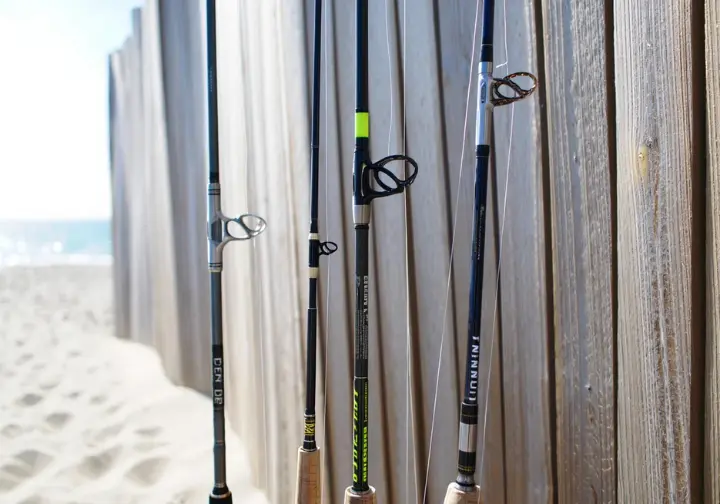
Navigating the sea of available surf rods can be daunting. Based on performance, value, and specific fishing applications, here are some highly recommended options to consider for your 2025 surf fishing adventures. These are considered some of the best surf rods available.
Best All-Around Performers
These rods strike an excellent balance of performance, durability, and features, making them suitable for a wide range of common surf fishing scenarios and species. They often become a go-to surf stick for many anglers.
Penn Battalion II Spinning | Good value, versatile, sensitive, durable build
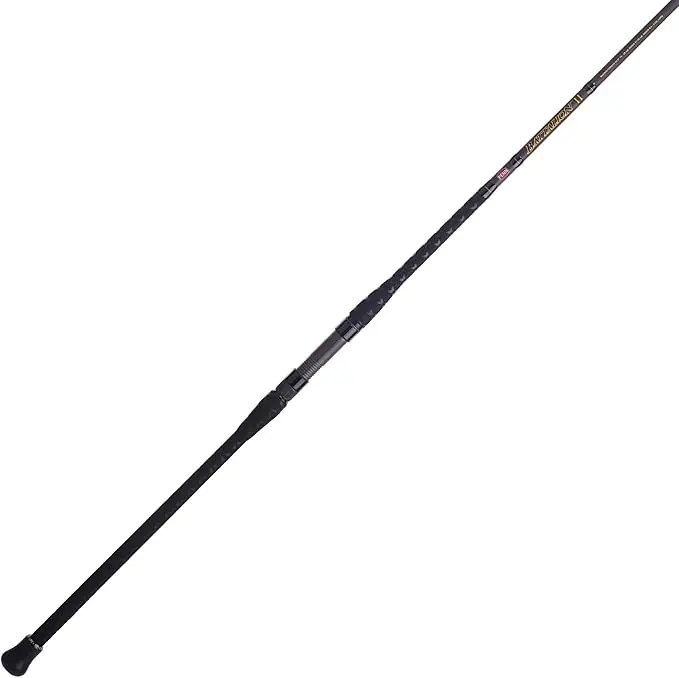
The PENN Battalion II series has earned a strong reputation among inshore and surf anglers for delivering impressive performance without breaking the bank. The 7’0″ Medium model reviewed in the outline is more suited for inshore, but the Battalion II Surf models (available in lengths like 10′, 11′, 12′) carry the same design philosophy: a blend of sensitivity and toughness. They utilize PENN’s SLC2 graphite blank construction, aiming for lightness and responsiveness to detect bites, paired with the backbone needed for common surf species like stripers and blues. This is a capable spinning rod.
These rods typically feature Fuji components, including aluminum oxide guides and graphite reel seats, known for their reliability in saltwater environments. The handles often combine cork with rubber shrink tube butts, providing comfort and a secure grip even when wet – a practical touch for the surf. Many users find the Battalion II Surf rods offer performance that punches above their price point, making them a versatile workhorse for anglers who fish various conditions and target multiple species. This could be your particular rod if value is key.
While perhaps not as feather-light or exquisitely sensitive as top-tier premium rods, the Battalion II Surf offers a compelling package for its cost. It represents a solid step up from entry-level gear, providing the durability needed for the harsh surf environment alongside the sensitivity required for consistent success. It’s a rod that feels capable and ready for action, whether casting plugs or soaking bait chunks.
PROS
- Excellent value for the performance offered.
- Versatile for various surf species and techniques.
- Sensitive blank for good bite detection.
- Durable construction with reliable components.
- Comfortable and secure grip design.
CONS
- Not as lightweight as premium graphite rods.
- Sensitivity might be slightly less than top-tier models.
- Warranty may be less extensive than some competitors.
St. Croix Seage Spinning | Versatile, great for stripers, comfortable, light blank
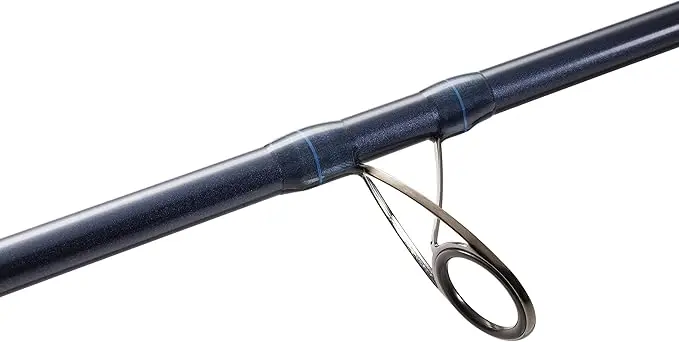
St. Croix’s Seage line quickly gained favor among serious surfcasters looking for a high-performance rod without venturing into the absolute highest price brackets. Built on St. Croix’s lighter SCII carbon blanks fortified with their FRS resin system, the Seage aims for a blend of sensitivity, lightness, and durability. Technologies like ART and Veil Tech are incorporated to enhance hoop strength and impact resistance – crucial for rods that inevitably get bumped around on jetties and rocks. This is one of the popular spinning rods for the surf.
The Seage rods, particularly models like the 10-foot surf rod Medium reviewed in the outline, are often praised for their versatility, excelling at casting popular striper lures like plugs and bucktails while retaining enough sensitivity for subtle takes. Ideal for many striper fishing situations. The moderate-fast action typical of many Seage models provides good casting distance and helps absorb shock during fights. Anglers appreciate the comfortable X-Flock handles with Winn foregrips, designed for long sessions on the beach.
While positioned below the flagship Legend Surf series, the Seage offers a significant portion of that performance DNA. It feels crisp, responsive, and capable of handling challenging fish and conditions. Some rare user reports mentioned ferrule fit issues or breakages, but St. Croix’s strong warranty generally provides good support. It’s a rod designed for the dedicated surfcaster who values performance and comfort.
PROS
- Excellent versatility for lures and some bait fishing.
- Lightweight and sensitive SCII carbon blank.
- Comfortable and secure grip system (X-Flock/Winn).
- Durable construction with ART/Veil Tech reinforcement.
- Strong 15-year transferable warranty.
CONS
- Higher price point than budget/mid-range options.
- Rare reports of ferrule fit issues or breakages.
- Longer models can be challenging to transport.
Top Budget-Friendly Options
Getting into surf fishing doesn’t require emptying your wallet. These rods offer commendable performance and durability at a more accessible price point, proving you don’t need expensive fishing rods to enjoy beach fishing fun.
Tsunami Airwave | Widely considered best value, solid performance
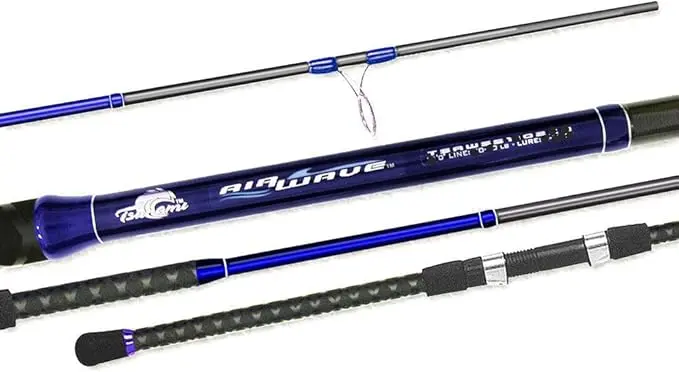
The Tsunami Airwave series has become almost legendary in surf fishing circles for offering outstanding performance at a budget-friendly price. Utilizing high-fiber-density graphite blanks, these rods are known for being surprisingly lightweight and responsive for their cost. They generate fast blank recovery speeds, translating into impressive casting distances, often rivaling rods costing significantly more. The 10’0″ Extra Heavy model mentioned in the outline highlights their capability for handling heavier payloads (3-6 oz) and larger fish. A very popular surf rod.
Airwave rods typically feature reliable Fuji Hardloy guides and graphite/stainless steel reel seats, components that hold up reasonably well to saltwater exposure with proper care. Handle configurations vary, often using durable cork or textured vinyl grips. While perhaps lacking the absolute refinement or cutting-edge tech of premium rods, the Airwave delivers where it counts: casting power, reasonable sensitivity, and the strength to land respectable fish. It’s a solid spinning rod choice.
It’s often recommended as a fantastic starting point for new surf anglers or a dependable backup/secondary rod for experienced ones. The combination of casting prowess and affordability makes it a hard-to-beat value proposition. While occasional quality control issues like ferrule fit can occur (as with many mass-produced rods), the overall track record is overwhelmingly positive, cementing its reputation as a surf fishing workhorse.
PROS
- Exceptional value – performance often exceeds price.
- Impressive casting distance for the cost.
- Lightweight design compared to other budget options.
- Durable enough for typical surf conditions.
- Available in a wide range of lengths and powers.
CONS
- Component quality (guides) not as premium as higher-end rods.
- Occasional reports of ferrule fit inconsistencies.
- Sensitivity is good for the price, but less than premium blanks.
- Warranty is typically shorter than premium brands.
Okuma Rockaway SP | Exceptional value, ultralight, highly sensitive for light tackle

The Okuma Rockaway SP stands out in the budget category, specifically targeting anglers who enjoy light tackle surf fishing. Built on lightweight 24/30-ton carbon blanks, these rods are exceptionally light and sensitive, designed primarily for detecting the subtle bites of species like surf perch or casting lighter lures (often in the 1/2-3 oz range) for stripers or halibut. The 11’0″ Medium+ model highlighted in the outline emphasizes this light-line focus, making it an excellent surf perch rod.
Featuring SeaGuide components, including stainless steel guide frames with zirconium inserts and minimalist EVA split grips, the Rockaway SP prioritizes weight reduction and feel. Anglers often rave about its sensitivity, allowing them to detect bites they might miss with heavier, less responsive rods. It offers remarkable performance, especially considering its very accessible price point, often under $150. This spinning rod feels great in hand.
The main drawback frequently cited by users isn’t the rod’s performance but issues related to shipping – inadequate packaging leading to damaged guides or tips upon arrival. When received intact, however, the rod is widely praised as an unbeatable value for light surf applications. It’s not designed for heavy bait soaking or battling giant fish, but for its intended purpose, it delivers sensitivity and casting ease that challenge much more expensive rods. The surf rod isn‘t meant for heavy duty work, but excels in its niche.
PROS
- Exceptional value for light tackle performance.
- Ultralight weight reduces casting fatigue.
- Highly sensitive blank excels at bite detection.
- Good casting distance with appropriate light lures.
- Comfortable minimalist grip design.
CONS
- Frequent reports of poor shipping packaging leading to damage.
- Not suitable for heavy lures (>3 oz) or large fish.
- Guide quality is good but perhaps less robust than premium options.
- Warranty duration is typically shorter (1 year).
Best for Long Casting / Bait
When the goal is to launch heavy bait rigs past the breakers or cover maximum water, these rods offer the necessary power and design features. These are often considered the best bait rods for distance.
Penn Carnage III | Good casting distance, strong backbone, value power
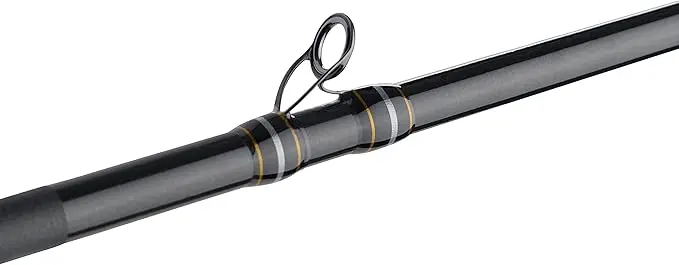
The PENN Carnage III Surf series is built for anglers who need power and casting distance, often for soaking large baits or throwing heavier lures. Utilizing PENN’s SLS3 blank construction, which incorporates spiral carbon wraps, these rods are designed to be thin, lightweight for their power rating, and durable, with fast energy recovery for launching rigs. The 11’0″ Medium Heavy conventional model in the outline, rated for 1-5 oz, showcases its capability for handling substantial payloads, making it a formidable heavy surf rod.
Equipped with high-quality Fuji K-Series tangle-free guides with SiC inserts (excellent for braid) and Fuji reel seats, the Carnage III doesn’t skimp on components. The rubber shrink tube handles provide a superior grip, especially in wet conditions, a feature many surf anglers prefer over cork or EVA. These rods possess a strong backbone, capable of handling large stripers, drum, or even sharks, giving anglers the confidence to winch fish through heavy surf. It’s a great heavy bait rod.
While delivering premium components and serious power often found in more expensive rods, the Carnage III maintains a relatively accessible price point (often low-to-mid $200s). It represents excellent value for anglers needing a powerful casting tool. Some users have reported shipping issues or rare ferrule fit problems, but the overall feedback points to a robust, high-performing rod that excels at distance bait fishing and throwing heavier plugs.
PROS
- Excellent casting distance with heavier payloads (2-5 oz).
- Strong backbone for fighting large surf species.
- Premium Fuji K-guides with SiC inserts.
- Durable and grippy rubber shrink tube handle.
- Good value considering the power and components.
CONS
- Can feel stiff for lighter lures (<1-2 oz).
- Reports of poor shipping packaging.
- Heavier than rods designed purely for sensitivity/finesse.
- Rare reports of ferrule fit issues.
Best for Lure Fishing (Plugging)
For anglers who live to cast artificial lures – plugs, bucktails, metals – these rods offer the sensitivity, responsiveness, and lightweight feel needed for active fishing. These are the top choices for dedicated lure rods in the surf.
Shimano Tiralejo XX | Premium sensitivity & power, accurate, resists twist

The Shimano Tiralejo XX series represents Shimano’s high-end offering for dedicated surfcasters, particularly those focused on lure fishing. Built using Shimano’s advanced C4S-HM blank construction combined with Spiral X and Hi-Power X technologies, these rods are engineered for exceptional strength-to-weight ratio, premium sensitivity, and remarkable twist resistance. This translates to highly accurate, long casts and the ability to feel subtle lure movements or bites. The 11’0″ Medium Heavy model in the outline (1-4 oz) fits squarely in the prime plugging category. This is a premium spinning rod.
Featuring top-tier Fuji K-Frame guides with SiC inserts and custom Shimano reel seats paired with durable shrink tube handles, the Tiralejo XX is built with quality components designed for harsh saltwater use. The focus on minimizing blank twist (torsional distortion) during the cast is a key selling point, leading to more precise lure placement and efficient energy transfer. Anglers often describe these rods as feeling crisp, powerful, and incredibly sensitive.
While carrying a premium price tag (often $300+), the Tiralejo XX delivers performance that rivals or exceeds many competitors in its class. It’s a specialized tool for the serious plugger who demands accuracy, sensitivity, and power in a lightweight package. The main potential drawbacks are the relatively short 1-year warranty compared to some competitors and occasional shipping concerns, but the on-the-water performance is widely lauded.
PROS
- Exceptional sensitivity for detecting bites and lure action.
- Powerful backbone combined with lightweight feel.
- Highly accurate casting due to twist-resistant blank tech (Spiral X/Hi-Power X).
- Premium Fuji K-guides with SiC inserts.
- Durable and comfortable shrink tube handle.
CONS
- Premium price point.
- Shorter warranty duration (1 year) compared to some competitors.
- Reports of poor shipping packaging.
- Can feel stiff for very light lures.
St. Croix Legend Surf | Top-tier plugging performance, lightweight, powerful, durable
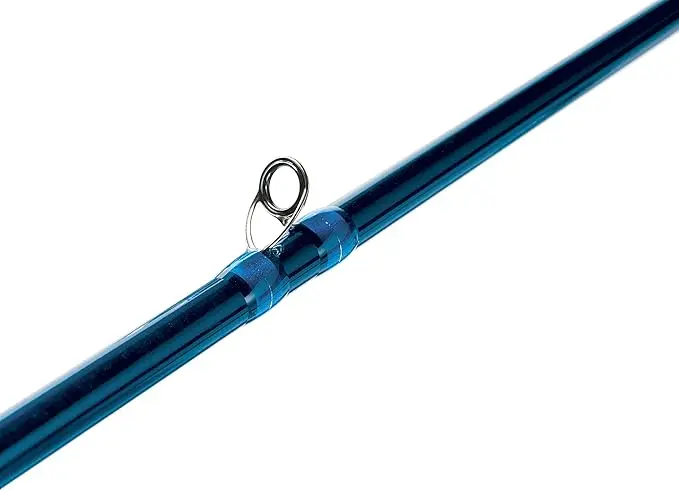
The St. Croix Legend Surf sits at the pinnacle of St. Croix’s surf rod lineup, designed for anglers seeking the ultimate in plugging performance. Utilizing their highest-grade SCIV carbon blanks combined with FRS, IPC mandrel technology, and ART reinforcement, these rods achieve an incredible balance of lightweight feel, sensitivity, power, and durability. The 10-foot surf rod Medium model (1-4 oz) highlighted in the outline is a prime example, beloved by striper anglers for its ability to work plugs effectively. It’s considered a super rod by many successful surfcasters.
Outfitted with the best components available, including Fuji K-Series KW tangle-free guides with titanium frames and slim SiC rings (completely corrosion-proof) and Fuji DPS Deluxe reel seats, no expense is spared. The custom neoprene handles offer excellent grip and comfort. The Legend Surf feels exceptionally light in hand, reducing fatigue during long sessions of casting and retrieving lures, yet possesses immense power to handle large fish and challenging conditions. This spinning rod is a top contender.
This level of performance comes at a significant cost (often $500+), placing it firmly in the premium category. However, for the dedicated surfcaster who demands the best in terms of weight, sensitivity, and power for lure fishing, the Legend Surf is often considered the benchmark. Backed by St. Croix’s 15-year warranty, it represents a long-term investment in top-tier surfcasting equipment. Could this be the premium drum rod you need?
PROS
- Top-tier plugging performance – sensitivity, casting, lure control.
- Exceptionally lightweight SCIV carbon blank.
- Powerful backbone for handling large fish.
- Highly durable construction with ART reinforcement.
- Premium, corrosion-proof Fuji titanium/SiC guides.
- Strong 15-year transferable warranty.
CONS
- Very high price point.
- Reports of poor shipping packaging.
- Can feel too stiff or powerful for very light tackle applications.
- Neoprene handle may show wear over time with heavy use.
Top Travel Rod Choices
For anglers on the move, these multi-piece rods offer portability without sacrificing too much performance, allowing you to take your fishing adventures anywhere. Finding a good travel fishing pole is key for mobile fishermen.
St. Croix Triumph Travel Spinning | Highly portable (4-piece), good balance/feel, versatile

The St. Croix Triumph Travel series provides a highly portable solution for anglers who need a rod that fits easily into luggage or a backpack. Built on reliable SCII carbon blanks, these 4-piece rods offer a good balance of sensitivity, strength, and lightweight feel, making them surprisingly capable performers despite their multi-piece design. The 6’6″ Medium model (1/4-5/8 oz) from the outline is geared more towards freshwater or very light inshore, but the concept applies across the line – delivering St. Croix quality in a travel-friendly format. This spinning rod is ready for adventure.
Featuring dependable Sea Guide components and comfortable cork handles, the Triumph Travel rods feel well-balanced and responsive, often exceeding expectations for a multi-piece rod. They come with a padded nylon case for protection during transit. While perhaps not possessing the absolute peak performance of their 1- or 2-piece counterparts, they offer remarkable versatility for anglers targeting bass, trout, pike, or smaller coastal species while away from home. You might even land your first fish on a trip with this rod.
The main concerns often revolve around potential breakage (sometimes linked to shipping damage or ferrule issues) and the adequacy of the soft case for rigorous air travel. However, backed by a 5-year warranty and offering solid performance at a moderate price point (around $150-$165), the Triumph Travel is a popular choice for anglers prioritizing portability and versatility.
PROS
- Excellent portability (4-piece design fits carry-on/backpack).
- Good balance, feel, and sensitivity for a travel rod.
- Versatile for freshwater and light inshore applications.
- Lightweight SCII carbon construction.
- Includes a protective padded soft case.
- Reputable brand with a 5-year warranty.
CONS
- Multi-piece design may have slight performance compromises vs. 1/2-piece.
- Reports of shipping damage or breakage concerns.
- Soft case may not be sufficient for air travel protection.
- Not designed for heavy surf or large saltwater species.
Daiwa Ardito Travel | Versatile multi-piece option, quality construction
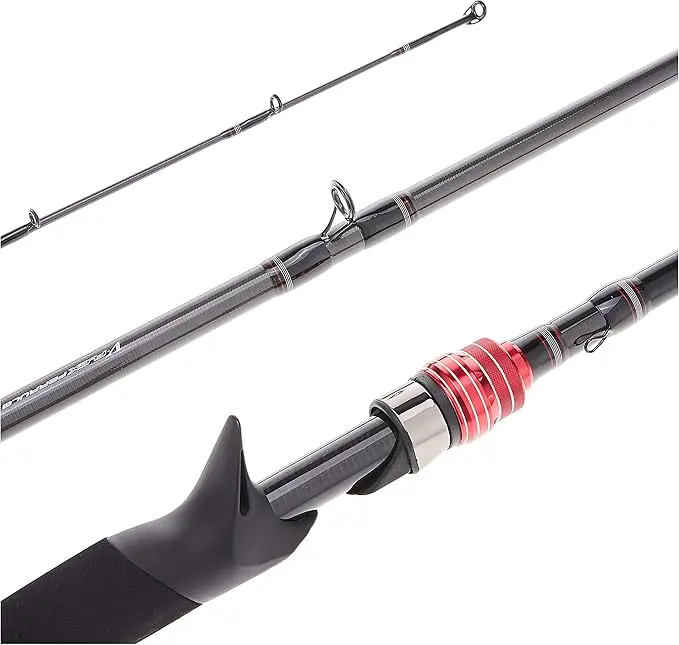
The Daiwa Ardito-TR series offers another excellent multi-piece travel rod option, known for its quality construction and versatility. Utilizing Daiwa’s HVF graphite blanks with X45 Bias construction, these 3-piece rods aim to deliver strength, flexibility, and minimal blank twist, resulting in sensitive and accurate casting performance that feels close to a 1-piece rod. The 7’0″ Medium Heavy casting model (1/4-1 oz) from the outline highlights its capability for handling a range of freshwater and light saltwater applications.
Featuring Fuji aluminum oxide guides and comfortable EVA split grips, the Ardito-TR is built with reliable components. A key feature is the V-Flex Ferrule Joint System, designed to ensure a smooth, uninterrupted bend through the connections. These rods come standard with a sturdy semi-hard travel case, offering better protection than typical soft cases, especially for anglers who travel frequently.
Priced very competitively (often around $100-$140), the Ardito-TR provides exceptional value, delivering performance that punches well above its weight. It’s praised for its balance, sensitivity, and ability to handle surprisingly large fish for a travel rod. While occasional shipping issues or rare breakages can occur, the combination of quality construction, a protective case, and Daiwa’s 5-year warranty makes it a compelling choice for the traveling angler.
PROS
- Excellent value for a quality multi-piece travel rod.
- Versatile for various freshwater and light saltwater species/lures.
- Quality HVF/X45 blank construction offers good sensitivity and power.
- V-Flex ferrules provide a smooth, 1-piece-like feel.
- Includes a sturdy semi-hard travel case.
- Lightweight and well-balanced design.
CONS
- Reports of shipping damage or rare breakages.
- Fuji aluminum oxide guides are good but not top-tier (like SiC).
- 3-piece design might be slightly less compact than 4-piece options.
- Not intended for heavy surf or large offshore species.
Pairing, Care, & Final Thoughts
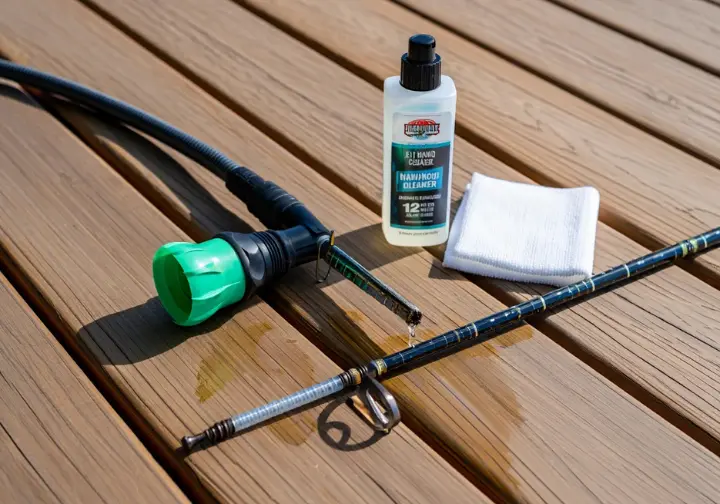
Selecting the rod is just the first step in building your surf fishing arsenal. Properly pairing it with a reel and line, followed by consistent maintenance, is essential for maximizing performance and ensuring your gear withstands the demanding coastal environment. Completing the rod and reel setup correctly is crucial.
Choosing the Right Reel
Achieving proper balance between your rod and reel is paramount for comfortable, efficient casting. A reel that’s too heavy or too light for the rod will feel awkward and lead to fatigue quickly. Generally, match the reel size (e.g., 4000, 5000, 6000 series for spinning reels) to the rod’s length and power rating. A 10-11ft Medium-Heavy rod often pairs well with a 5000-6500 size reel. Consider specialized surf fishing reels for optimal performance.
Critically, ensure you select a reel specifically designed for saltwater use. Look for features like corrosion-resistant body materials (aluminum, reinforced graphite) and sealed components, particularly the drag system and key bearings, to keep salt and sand out. Brands like PENN, Daiwa, and Shimano offer many reliable saltwater models. Adequate line capacity is also vital for long casts and potential long runs from powerful fish. Check the reel’s specifications for capacity based on your chosen line type and strength.
Don’t overlook the drag system’s quality. A smooth, consistent drag is non-negotiable for tiring out strong fish in the surf without risking line breaks. Consider the gear ratio too – higher ratios retrieve line faster, which can be useful for lure fishing, while lower ratios offer more cranking power. If possible, mount the reel on the rod in a shop to check the physical balance and ensure a secure fit in the reel seat.
Line Selection: Braid vs. Mono
The choice between braided fishing line and monofilament often comes down to personal preference and fishing style, but braid offers distinct advantages for surf fishing. Its thinner diameter allows for significantly greater line capacity on the reel and cuts through wind and current more effectively, leading to longer casts and better rig control. Braid’s near-zero stretch provides unparalleled sensitivity for detecting bites, even at long distances, crucial when fish aren‘t aggressive.
However, braid’s lack of stretch necessitates using a shock leader – a length of heavier monofilament or fluorocarbon tied between the braid and the terminal tackle. This leader absorbs the shock of casting heavy weights, provides abrasion resistance against rough bottoms or fish teeth, and adds a crucial bit of elasticity during the final stages of the fight, especially when the fish is close to shore. Choosing the right line is crucial for successful surf fishing, impacting distance and durability.
Monofilament fishing line is more affordable and its inherent stretch can be forgiving, acting as a built-in shock absorber. This can be beneficial, especially when using lures with treble hooks. However, its thicker diameter reduces casting distance and sensitivity compared to braid. Mono is often easier for beginners to manage and tie knots with. Fluorocarbon leaders offer lower visibility and higher abrasion resistance than mono but come at a higher cost.
Essential Rod Maintenance & Care
Consistent care is vital to prolonging the life of your surf rod in the harsh saltwater environment. The single most important step is to rinse your rod thoroughly with fresh water after every single trip. Use low pressure and pay close attention to the guides and reel seat, gently wiping down the blank with a soft cloth afterward. This prevents issues that could lead to rod breaks.
Periodically inspect the guide rings for any cracks, chips, or grooves, especially when using braid, as damaged guides will quickly fray your fishing line. Clean guide frames and rings with a Q-tip or soft brush to remove salt buildup. Check the blank for deep scratches that could compromise its strength. Ensure ferrules on multi-piece rods fit snugly and are free of debris.
Store your rods properly, ideally vertically in a rack or supported horizontally to prevent warping. Keep them out of prolonged direct sunlight and extreme heat. Finally, always use a rod sleeve or protective tube during transport. This simple precaution prevents countless dings, scratches, and breaks caused by car doors, shifting gear, or accidental impacts, especially crucial for delicate graphite rods.
Reeling In Your Decision
Choosing the best fishing rod for surf fishing boils down to understanding the gear’s mechanics and honestly assessing your own needs – the fish you target, the way you like to fish (fishing style), where you fish (beach fishing, jetty, etc.), and your budget. It’s like solving the surf-rod puzzle. We’ve cast a wide net covering length, power, action, materials, and highlighted some top contenders for 2025, from versatile all-rounders like the Penn Battalion II or St. Croix Seage, to budget stars like the Tsunami Airwave and Okuma Rockaway SP, powerful casters like the Penn Carnage III, plugging machines like the Shimano Tiralejo XX and St. Croix Legend Surf, and portable travel options. These beach rods cover many bases.
Remember, the rod is only part of the equation. Pair it thoughtfully with a suitable saltwater reel and the right line, and commit to rinsing and caring for your equipment after each outing involving surf casting or surfcasting. Armed with this knowledge, you’re well-equipped to select the surf rod that will serve you well on the beach. Go ahead, make your choice, and become the Beach Boss!
Frequently Asked Questions
What’s the best all-around length for a surf fishing rod? >
Should I choose braid or monofilament line for surf fishing? >
How important is rinsing my rod after saltwater fishing? >
Do I need an expensive rod to start surf fishing? >
We are a participant in the Amazon Services LLC Associates Program, an affiliate advertising program designed to provide a means for sites to earn advertising fees by advertising and linking to Amazon.com. As an Amazon Associate I earn from qualifying purchases. We also participate in other affiliate programs. The information provided on this website is provided for entertainment purposes only. We make no representations or warranties of any kind, expressed or implied, about the completeness, accuracy, adequacy, legality, usefulness, reliability, suitability, or availability of the information, or about anything else. Any reliance you place on the information is therefore strictly at your own risk. Additional terms are found in the terms of service.


